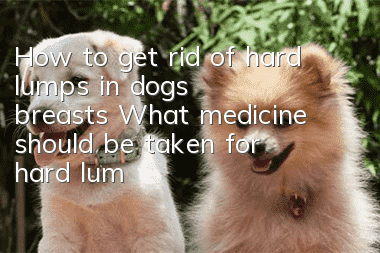How to get rid of hard lumps in dog’s breasts? What medicine should be taken for hard lumps in dog’s breasts?

Canine breast lumps may be due to mastitis
There are many causes of canine mastitis. For example, a large amount of latex is retained in the female dog’s breast, the dog bites the nipple during breastfeeding, or the breast is squeezed or Mastitis can also be caused by friction, and this disease has become a common disease.If a female dog develops mastitis, the sooner it is treated, the better the effect will be. If it becomes chronic, she will easily lose her lactation ability even if she is cured.
1. Once a female dog is found to have symptoms of mastitis, the puppies should be isolated immediately, the breasts should be cleaned and the milk should be expressed every 2 to 3 hours during the day and every 6 hours at night. Reduce breast pressure and relieve pain.
2. Antibiotic nipple injection has good effect. After the female dog expresses her milk, penicillin and streptomycin should be injected into the mammary gland through the milk duct, 1 to 2 times a day. After injecting, pinch the nipple with two fingers and gently rub the breast to spread the medicine as much as possible. The milk should be expressed before each injection.
A lump in the dog’s breast may be due to false pregnancy
The reasons for false pregnancy symptoms in dogs after going into heat are:1. Endocrine disorders lead to abnormal hormone secretion in the body;
2. Improper mating , the mating period is inappropriate after estrus and ovulation;
3. Lack of exercise and genital diseases.
Dogs suffering from pseudopregnancy need to eat properly, drink less water, and milk the dog every day; in cases of pseudopregnancy in dogs, which are more serious, hormone treatment can be used appropriately. If methyltestosterone is taken orally, 10 mg per day.
Dogs have lumps in their breasts or mammary cysts
Dogs that have not been neutered may develop mammary tumors in middle age or later in life. Unneutered dogs are prone to uterine and mammary gland problems due to excess estrogen in their bodies.Most dog mammary tumors are benign.
However, a small number of malignant breast tumors will enlarge, ulcerate, bleed, and even migrate to the lungs, causing secondary tumors in the lungs and symptoms such as coughing and dyspnea.
The treatment of breast cysts requires professional antibiotic preparation and injection, so it is recommended to send it to a pet hospital for treatment.
- What do dogs eat to protect their stomach? It is important to protect their stomach and treat gastrointestinal diseases in dogs.
- How to tell if your dog is fat? Is your dog overweight?
- Will your dog catch a cold if you blow the air conditioner? What should you do if your dog catches a cold if you blow the air conditioner?
- What should you pay attention to when your dog drinks water? Don’t be careless when it comes to your dog’s drinking water.
- The dog's mouth bites and shakes. Why does the dog's mouth occasionally shake and bite?
- How to cut a dog's hair? Do you know how to cut a dog's hair correctly?
- Can dogs eat raw eggs? Why can’t dogs eat egg whites?
- Common Dog Problems in Summer How to Deal with Different Dog Problems
- How to keep dogs away from skin diseases. If you do this, will you see if your dog will still be infected with skin diseases?
- What causes anorexia in dogs? Dogs will become anorexic due to lack of exercise. Hounds run at least 5KM every day.



